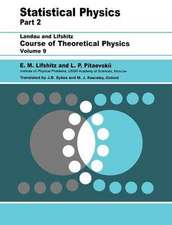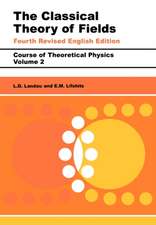Fundamentals of Plasma Physics
Autor J. A. Bittencourten Limba Engleză Paperback – 30 sep 2010
Throughout the text the emphasis is on clarity, rather than formality, the various derivations are explained in detail and, wherever possible, the physical interpretations are emphasized. The mathematical treatment is set out in great detail, carrying out the steps which are usually left to the reader. The problems form an integral part of the text and most of them were designed in such a way as to provide a guideline, stating intermediate steps with answers.
| Toate formatele și edițiile | Preț | Express |
|---|---|---|
| Paperback (1) | 616.41 lei 6-8 săpt. | |
| Springer – 30 sep 2010 | 616.41 lei 6-8 săpt. | |
| Hardback (1) | 684.08 lei 38-44 zile | |
| Springer – 17 iun 2004 | 684.08 lei 38-44 zile |
Preț: 616.41 lei
Preț vechi: 725.19 lei
-15% Nou
Puncte Express: 925
Preț estimativ în valută:
117.94€ • 123.16$ • 97.40£
117.94€ • 123.16$ • 97.40£
Carte tipărită la comandă
Livrare economică 15-29 aprilie
Preluare comenzi: 021 569.72.76
Specificații
ISBN-13: 9781441919304
ISBN-10: 1441919309
Pagini: 704
Ilustrații: XXIII, 679 p. 328 illus.
Dimensiuni: 178 x 254 x 37 mm
Greutate: 1.32 kg
Ediția:Softcover reprint of hardcover 3rd ed. 2004
Editura: Springer
Colecția Springer
Locul publicării:New York, NY, United States
ISBN-10: 1441919309
Pagini: 704
Ilustrații: XXIII, 679 p. 328 illus.
Dimensiuni: 178 x 254 x 37 mm
Greutate: 1.32 kg
Ediția:Softcover reprint of hardcover 3rd ed. 2004
Editura: Springer
Colecția Springer
Locul publicării:New York, NY, United States
Public țintă
GraduateDescriere
Fundamentals of Plasma Physics is a general introduction designed to present a comprehensive, logical and unified treatment of the fundamentals of plasma physics based on statistical kinetic theory, with applications to a variety of important plasma phenomena. Its clarity and completeness makes the text suitable for self-learning and for self-paced courses.
Throughout the text the emphasis is on clarity, rather than formality, the various derivations are explained in detail and, wherever possible, the physical interpretations are emphasized. The mathematical treatment is set out in great detail, carrying out the steps which are usually left to the reader. The problems form an integral part of the text and most of them were designed in such a way as to provide a guideline, stating intermediate steps with answers.
Throughout the text the emphasis is on clarity, rather than formality, the various derivations are explained in detail and, wherever possible, the physical interpretations are emphasized. The mathematical treatment is set out in great detail, carrying out the steps which are usually left to the reader. The problems form an integral part of the text and most of them were designed in such a way as to provide a guideline, stating intermediate steps with answers.
Cuprins
CONTENTS 1. General Properties of Plasmas 1.1 Definition of a Plasma 1.2 Plasma as the Fourth State of Matter 1.3 Plasma Production 1.4 Particle Interactions and Collective Effects 1.5 Some Basic Plasma Phenomena 2. Criteria for the De.nition of a Plasma 2.1 Macroscopic Neutrality 2.2 Debye Shielding 2.3 The Plasma Frequency 3. The Occurrence of Plasmas in Nature 3.1 The Sun and its Atmosphere 3.2 The Solar Wind 3.3 The Magnetosphere and the Van Allen Radiation Belts 3.4 The Ionosphere 3.5 Plasmas Beyond the Solar System 4. Applications of Plasma Physics 4.1 Controlled Thermonuclear Fusion 4.2 The Magnetohydrodynamic Generator 4.3 Plasma Propulsion 4.4 Other Plasma Devices 5. Theoretical Description of Plasma Phenomena 5.1 General Considerations on a Self-Consistent Formulation 5.2 Theoretical Approaches Problems 1. Introduction 2. Energy Conservation 3. Uniform Electrostatic Field 4. Uniform Magnetostatic Field 4.1 Formal Solution of the Equation of Motion 4.2 Solution in Cartesian Coordinates 4.3 Magnetic Moment 4.4 Magnetization Current 5. Uniform Electrostatic and Magnetostatic Fields 5.1 Formal Solution of the Equation of Motion 5.2 Solution in Cartesian Coordinates 6. Drift Due to an External Force Problems 1. Introduction 2. Spatial Variation of the Magnetic Field 2.1 Divergence Terms 2.2 Gradient and Curvature Terms 2.3 Shear Terms 3. Equation of Motion in the First Order Approximation 4. Average Force Over One Gyration Period 4.1 Parallel Force 4.2 Perpendicular Force 4.3 Total Average Force 5. Gradient Drift 6. Parallel Acceleration of the Guiding Center 6.1 Invariance of the Orbital Magnetic Moment and of the Magnetic Flux 6.2 Magnetic Mirror Effect 6.3 The Longitudinal Adiabatic Invariant 7. Curvature Drift 8. Combined Gradient-Curvature Drift Problems 1. Introduction 2. Slowly Time-Varying Electric Field 2.1 Equation of Motion and Polarization Drift 2.2 Plasma Dielectric Constant 3. Electric Field with Arbitrary Time Variation 3.1 Solution of the Equation of Motion 3.2 Physical Interpretation 3.3 Mobility Dyad 3.4 Plasma Conductivity Dyad 3.5 Cyclotron Resonance 4. Time-Varying Magnetic Field and Space-Varying Electric Field 4.1 Equation of Motion and Adiabatic Invariants 4.2 Magnetic Heating of a Plasma 5. Summary of Guiding Center Drifts and Current Densities 5.1 Guiding Center Drifts 5.2 Current Densities Problems 1. Introduction 2. Phase Space 2.1 Single-Particle Phase Space 2.2 Many-Particle Phase Space 2.3 Volume Elements 3. Distribution Function 4. Number Density and Average Velocity 5. The Boltzmann Equation 5.1 Colisionless Boltzmann Equation 5.2 Jacobian of the Transformation in Phase Space 5.3 E.ects of Particle Interactions 6. Relaxation Model for the Collision Term 7. The Vlasov Equation Problems 1. Average Value of a Physical Quantity 2. Average Velocity and Peculiar Velocity 3. Flux 4. Particle Current Density 5. Momentum Flow Dyad or Tensor 6. Pressure Dyad or Tensor 6.1 Concept of Pressure 6.2 Force per Unit Area 6.3 Force per Unit Volume 6.4 Scalar Pressure and Absolute Temperature 7. Heat Flow Vector 8. Heat Flow Triad 9. Total Energy Flux Triad 10. Higher Moments of the Distribution Function Problems 1. The Equilibrium State Distribution Function 1.1 The General Principle of Detailed Balance and Binary Collisions 1.2 Summation Invariants 1.3 Maxwell-Boltzmann Distribution Function 1.4 Determination of the Constant Coe.cients 1.5 Local Maxwell-Boltzmann Distribution Function 2. The Most Probable Distribution 3. M
Recenzii
From the reviews of the third edition:
"This is an excellent introductory textbook of plasma physics, especially recommendable to those starting the study of the subject. … the book is an immense monography of 678 pages. Our impressions are good … ." (Iván Abonyi, Zentralblatt MATH, Vol. 1084, 2006)
"This is an excellent introductory textbook of plasma physics, especially recommendable to those starting the study of the subject. … the book is an immense monography of 678 pages. Our impressions are good … ." (Iván Abonyi, Zentralblatt MATH, Vol. 1084, 2006)
Textul de pe ultima copertă
Fundamentals of Plasma Physics is a comprehensive textbook designed to present a logical and unified treatment of the fundamentals of plasma physics based on statistical kinetic theory, with applications to a variety of important plasma phenomena. The clarity and completeness of the text makes it suitable for self-learning.
Throughout the text the emphasis is on clarity, rather than formality. The various derivations are explained in detail and, wherever possible, the physical interpretations are emphasized. The mathematical treatment is set out in great detail, carrying out steps that are usually left to the reader. The problems form an integral part of the text and most of them were designed in such a way as to provide a guideline for the student, stating intermediate steps with answers.
The book is intended primarily for advanced undergraduate and first year graduate students meeting the subject of plasma physics for the first time and is suitable for those who have taken classical mechanics, electrodynamics and mathematics beyond sophomore level.
It is a valuable compendium for any serious student of plasma physics at the level of research student or research worker and it is also of interest to researchers in other related fields, such as space physics and applied electromagnetism.
Throughout the text the emphasis is on clarity, rather than formality. The various derivations are explained in detail and, wherever possible, the physical interpretations are emphasized. The mathematical treatment is set out in great detail, carrying out steps that are usually left to the reader. The problems form an integral part of the text and most of them were designed in such a way as to provide a guideline for the student, stating intermediate steps with answers.
The book is intended primarily for advanced undergraduate and first year graduate students meeting the subject of plasma physics for the first time and is suitable for those who have taken classical mechanics, electrodynamics and mathematics beyond sophomore level.
It is a valuable compendium for any serious student of plasma physics at the level of research student or research worker and it is also of interest to researchers in other related fields, such as space physics and applied electromagnetism.
Caracteristici
Fundamentals of Plasma Physics is a general introduction designed to present a comprehensive, logical and unified treatment of the fundamentals of plasma physics based on statistical kinetic theory, with applications to a variety of important plasma phenomena
Includes supplementary material: sn.pub/extras
Includes supplementary material: sn.pub/extras
























